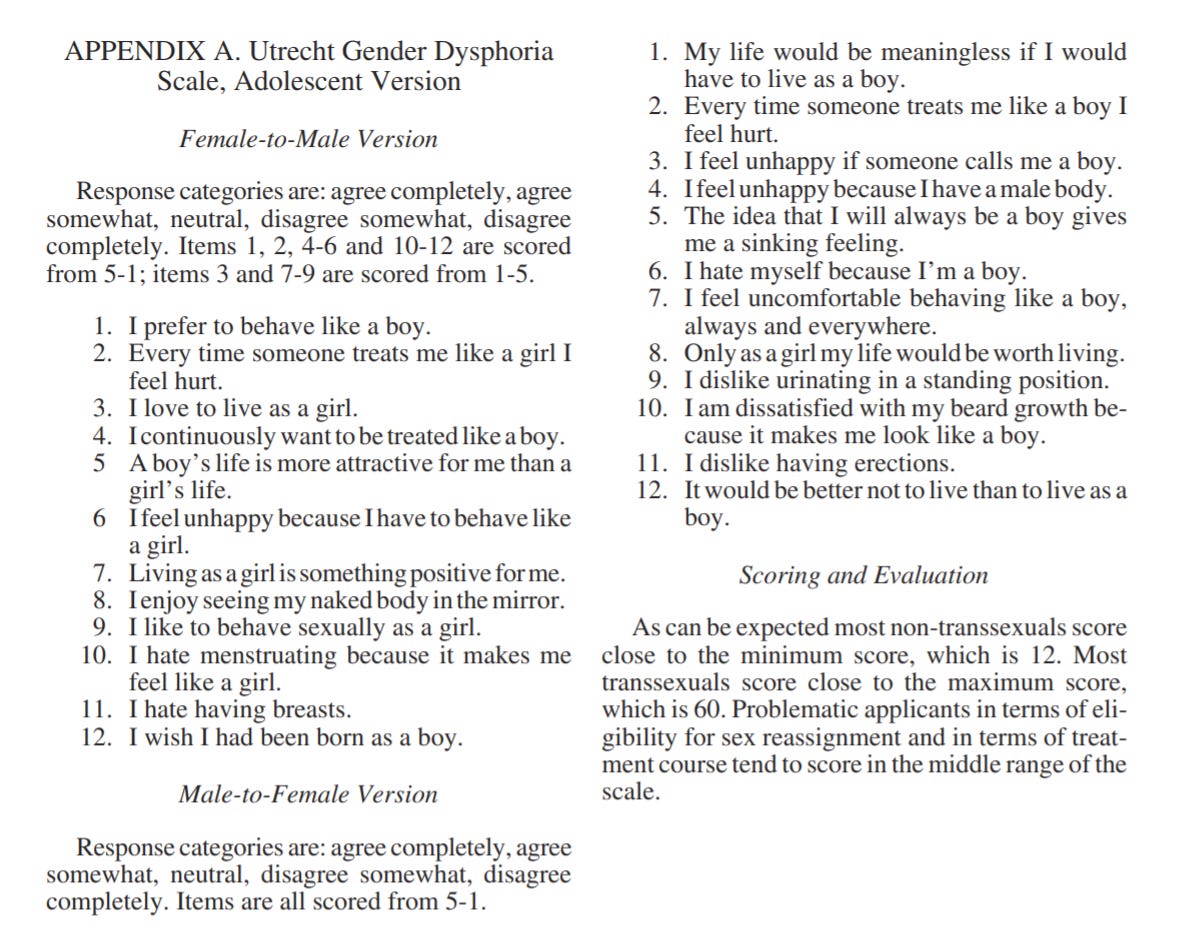The Gender-Affirming House of Cards
The Unstable Foundations of a So-Called Medical Consensus
Today’s guest post by Lisa Selin Davis notes that the claims for the efficacy of gender affirming care” for children and adolescents is founded on a grand total of two studies of 70 adolescents treated with puberty blockers whose questionable methodology a recent study scrutinized and found wanting. It is one example of a broader phenomenon afflicting the parts of the social scientific apparatus that touch upon subjects held to be within the purview of the causes that have adopted the spirit of ideological succession — that spirit which under the guise of “moral clarity” and other nostrums rejects nuance on principle and bends reality to suit its will, corrupting the very methods we use to seek truth in the service of ideology.
This study, as with so many others of its kind, arrives at its results through a flaw in method easy to spot by the minimally informed in social scientific method. So easy that one struggles to imagine how anything other than active connivance or passive acquiescence by journal editors terrorized into compliance by activist mobs could allow it to be published. The more one knows about the “science” being used to justify placing children on a path to hormonal and surgical interventions, the more one recognizes it as a kind of Collateralized Debt Obligation: constructed out of low-quality studies that are then aggregated into a new entity, which is blessed by the proverbial ratings agency of captured institutions — and then wielded as a blunt instrument by activists claiming a medical “consensus” where none exists. The bizarre claims are then repeated ad nauseum by officials, instituted into policy by organs of the medical establishment, and mouthed by the President of the United States himself — even as medical establishments across Europe evaluating the same data pull back from such policies.
By Lisa Selin Davis
Earlier this week, Republican Senator Mike Braun questioned U.S. Department of Health and Human Services Secretary Xavier Becerra about the hot topic of gender-affirming care for children and adolescents. “In what case would it be appropriate to perform irreversible sex change surgeries on kids?” Braun asked Becerra.
Becerra assured Braun that the FDA wouldn’t approve interventions like cross-sex hormones or mastectomies if they weren’t safe and effective, and that trans youth are getting “the life-affirming care that they need,” noting that many have taken their lives.
Putting aside for a minute that there is very little evidence to support Becerra’s suicide claims, including that gender-affirming care actually mitigates the risk of suicide, let’s focus on the claim about the safety and efficacy of puberty blockers and cross-sex hormones—prescribed off label, as Braun accurately notes—and of sex change surgeries, as they used to be known euphemistically (since sex can’t actually be changed).
Where did ideas like Becerra’s come from? You might think there’s a wide evidence base, but the entire field of gender affirming care sprang from two papers—whose conclusions have now been persuasively challenged.
In 2011, Dutch researchers published a study of 70 adolescents, whom they called “young transsexuals.” (This is before the word “transgender” was in vogue and transsexual was considered objectionable.) The doctors had gone a novel route in addressing their gender dysphoria by prescribing gonadotropin-releasing hormone analogues (GnRHa)—now known as puberty blockers—“to relieve the suffering caused by the development of secondary sex characteristics” such as breasts or Adam’s apples, “and to provide time to make a balanced decision regarding actual gender reassignment.” They were likely also delaying puberty to prevent boys from having a “never disappearing masculine appearance,” as an earlier Dutch paper put it. That is, if they went through male puberty, they couldn’t pass as women later.
All the children in the study had classic early child-onset gender dysphoria—insistent, persistent, and consistent—quite unlike the teens coming out suddenly today; they didn’t accept that kind of patient in the study. The mean age when they received puberty blockers was just shy of 15. The researchers assessed them before administering blockers and then later, just before administering cross-sex hormones, monitoring them for behavioral and emotional problems, general function, anxiety, anger, gender dysphoria and body satisfaction.
The results were mixed, though they’re often reported as proof that puberty blockers are a panacea. Researchers used some standard psychological assessment tools to measure anger and anxiety, which didn’t improve, and behavioral and emotional problems and general functioning, which improved a small but insignificant amount. They also used a new scale they’d invented to measure gender dysphoria and body satisfaction—which didn’t shift.
Three years later, the same group published another study, with 55 of the original 70 candidates who’d gone on to take cross-sex hormones and undergone what we now call gender-affirming surgeries: “vaginoplasty for transwomen, mastectomy and hysterectomy with ovariectomy for transmen.” That is, they had all been surgically sterilized. One of the 15 not included in the second paper died from necrotizing fasciitis after vaginoplasty; three developed diabetes and obesity during the treatment, and dropped out; the others failed to continue or weren’t yet one year past surgery.
The study noted that “Improvements in psychological functioning were positively correlated with postsurgical subjective well-being.” The researchers concluded that the Dutch protocol, as it would come to be known, “provides gender dysphoric youth who seek gender reassignment from early puberty on, the opportunity to develop into well-functioning young adults.” This conclusion became the basis of gender-affirming care, the foundation on which the model of puberty blockers, cross-sex hormones and surgeries for children with gender dysphoria rests.
But in March of this year, researchers and clinicians Stephen B. Levine, E. Abbruzzese and Julia W. Mason published a paper that called into question the very methodology of the study, and therefore the two studies’ conclusions—not to mention any policy decisions that have flowed from them. "Both of the studies suffer from a high risk of bias due to their study design, which is effectively a non-randomized case series—one of the lowest levels of evidence,” reads the paper, Reconsidering Informed Consent for Trans-Identified Children, Adolescents, and Young Adults, published in the Journal of Sex & Marital Therapy. “We contend that the Dutch studies have been misunderstood and misrepresented as providing evidence of the safety and efficacy of these interventions for all youth.”
Here's why: The tool they created and used to measure gender dysphoria was the Utrecht Gender Dysphoria Scale (UGDS), a 12-item questionnaire with boy and girl versions. Male and female participants were asked to rate statements like “I dislike having erections” or “A boy’s life is more attractive for me than a girl’s life,” respectively, on a five point scale, from “agree completely” to “disagree completely.” Before treatments began, natal girls were given the female UGDS questionnaire, and natal boys the male version. But then, at least a year after medical and surgical gender reassignment, the kids answered the questions geared toward the opposite sex.
So, a natal girl who scored very high on the UGDS because of how she responded to “I wish I had been born as a boy” then transitioned and scored very low when she responded to “It would be better not to live than to live as a boy.”
The issue here is not just that they switched the measuring instrument for the last measurement, effectively comparing apples to oranges. It’s that respondents would have recorded these answers whether they’d gone through any physical changes or not. A gender dysphoric boy might have agreed strongly with “My life would be meaningless if I would have to live as a boy” and with “Living as a girl is something positive for me,” whether or not that child’s penis had been removed. There’s no way to pin these answers to the medical interventions, to establish causation.
The Informed Consent authors write, “We maintain that this handling of the scales may have at best obscured, and at worst, severely compromised the ability to meaningfully track how gender dysphoria was affected throughout the treatment.”
Methodology aside, the data weren’t particularly strong anyway. “Of the 30 psychological measurements reported, nearly half showed no statistically significant improvements,” notes Levine et al. Thus: “The study cannot be used as evidence that these procedures have been proven to improve depression, anxiety, and suicidality.”
There are other issues with the studies that call into question whether they can be applied to kids with gender dysphoria today. For one thing, the kids all had high psychological function in the beginning. The fact that their psychological function was still high at the end doesn’t mean the surgeries and hormones are responsible for that. Many kids presenting at clinics today have complex mental health problems, unlike the kids in the Dutch study. And all kids in the Dutch study had early onset gender dysphoria. If they’d been like the kids presenting today, with vast mental health issues and late-onset dysphoria, they’d have been excluded. Why should these results—even if they were good—be applied to today’s cohort? How would they ensure that Becerra’s statements were accurate?
On the podcast Gender: A Wider Lens, two of those pioneering Dutch researchers, Annelou L C de Vries and Thomas D Steensma, admitted there were problems with the scale, but their issue was that “It’s very binary and it’s maybe not the most ideal instrument to measure gender dysphoria.” Researchers have since created a new tool, to accommodate the measuring of gender dysphoria in non-binary people, who might not express their distress according to bi-gendered language.
It's hard to see how that’s the answer to the serious allegation being raised here, which is that we are administering life-altering interventions to children on the basis of poor-quality research. A study that showed socially transitioned children tend to persist in their trans identities five years later made headlines across the left and mainstream media this week. But the Informed Consent paper was ignored by the press when it was published. It should have been a bombshell. If we weren’t living in such polarized times, this might have been a moment to reassess whether gender-affirming care is actually the best way to treat todays’ gender dysphoric youth. Instead, it’s yet another missed opportunity.






Another paper Lisa Selin Davis may want to investigate is "Race times for transgender athletes." by Joanna Harper, Journal of Sporting Cultures and Identities 6, no. 1 (2015): 1-9. The entire paper is built on a misinterpretation of a high p value. Here the high p value was treated as affirmative evidence of no difference between two groups which is an incorrect interpretation. A more accurate interpretation is that there were not enough subjects to come to any firm conclusions either way.
Still, this paper was hailed in Science etc. as a breakthrough and before you know it, Joanna Harper was sitting on Olympic advisory committees. It is the exact same type of phenomena you describe and high time someone looked into it.
Great article, Ms. Davis. I am very sympathetic to the struggles transgender people face, but that doesn't mean society (including a publicly-funded health care system) should take shortcuts past the real science just because of people's feelings.
In too many cases, research in this area is outright manipulated (not even counting all the censorship going on). Jesse Singal did a great investigation in one of the papers which support the ideology rather than the science: https://jessesingal.substack.com/p/researchers-found-puberty-blockers?s=r